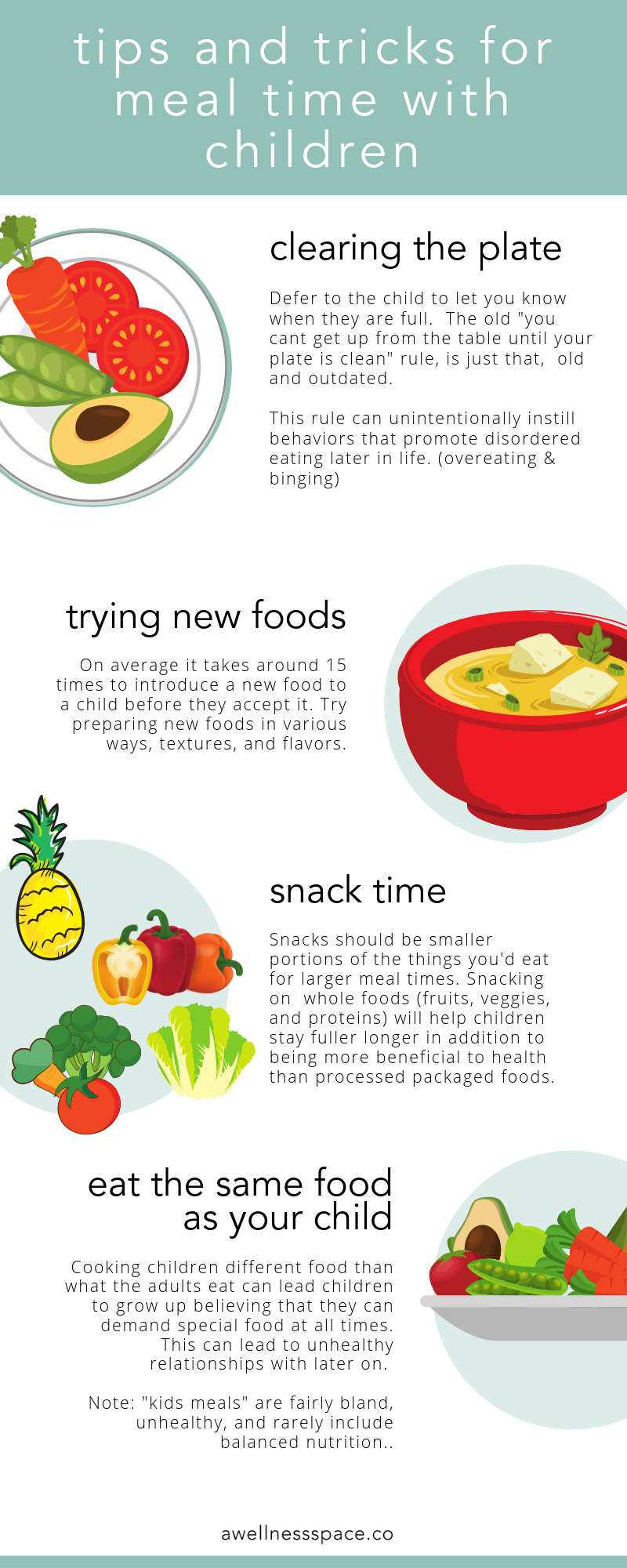Healthy Children Tips and Tricks
teach them young
Believe it or not, children begin to absorb the habits of the adults around them long before we think they might. We all want our children to grow up healthy and happy, and their relationship with food is the perfect place to start. Here’s some simple tips to make eating and cooking for children a little easier and healthier for everyone involved.

1.
they dont need to clear the plate
Defer to the child to let you know when they are full. The old “you cant get up from the table until your plate is clean” rule, is just that, old and outdated. This rule can unintentionally instill behaviors that promote disordered eating later in life. Growing up feeling like they have to finish their plate teaches children young to eat past their bodies natural signals that tell them they are full. By ignoring their bodies signals for many years, by the time they become adults it’s very hard to recognize and respect when their body tells them it’s full.
If you’re rewarding your child with dessert after they finish their plate they could not only be overeating at a young age, they may also begin to see food as a “reward”. When they get older their thoughts may turn into “Well, I’ve been good all day, so I deserve this late night dessert.” While there is nothing wrong with treating yourself with a yummy treat, it’s a healthy practice to do our best as seeing food as something we deserve or a reward.
2.
introducing new foods
Did you know that on average it can take around 15 times to introduce a new food to a child before they accept it as something they like? The same goes for adults too. There are many people who grew up thinking they hated a specific food because of how their parents cooked it, but many years later they end up trying it again from a friend or a restaurant and surprise, they actually end up loving this food.
Try preparing new foods in various ways, textures, and flavors. Use sauces and toppings such as nuts or seeds. Try emulating a food you already know they love (plant-based chicken nuggets, when introducing soy). Let them help prepare the new food, there’s a good chance some of it will end up in their mouth before it even hits the plate.
3.
healthy snacking
Snacks should be smaller portions of the things you’d eat for larger meal times. Snacking on whole foods (fruits, veggies, proteins, and whole grains) will help children stay fuller longer in addition to being more beneficial to health than processed packaged foods.
Packaged foods typically are higher in calories, sodium, and even fat. They usually spike our sugar quickly leaving us hungry again shortly after. That’s something everyone should avoid when possible, but especially important for children. No one wants a 3pm sugar rush to be met with a 4pm hungry child a few hours before dinner is even ready.
4.
eat the same food as your child
Cooking children different food than what the adults are eating can lead children to grow up believing that they can demand special food at all times. This can lead to unhealthy relationships with later on. They might continue to be picky as they get older which can lead to nutrient deficiencies when taken to the extreme. “Kids meals” are fairly bland, unhealthy, and rarely include balanced nutrition. Fill the whole family’s plates with colorful foods, whole grains, and healthy fats.
5.
eat organic when possible
Did you know that children are more vulnerable to pesticides than adults? Because children have an immature immune system it takes the body longer to detox and contaminants that enter the body, so pesticides may stay in the body longer. In addition, developing brains are more penetrable than those fully developed. Organic foods can be more expensive, so make sure to check out the Dirty Dozen and Clean Fifteen list. Buy what you can in organic from the Dirty Dozen list, these are foods that have tested higher in pesticides. Buy conventional food from the Clean Fifteen list, these are foods that have ranked lowest in pesticides. Note that this list changes every year, make sure you stay up to date.
share it



